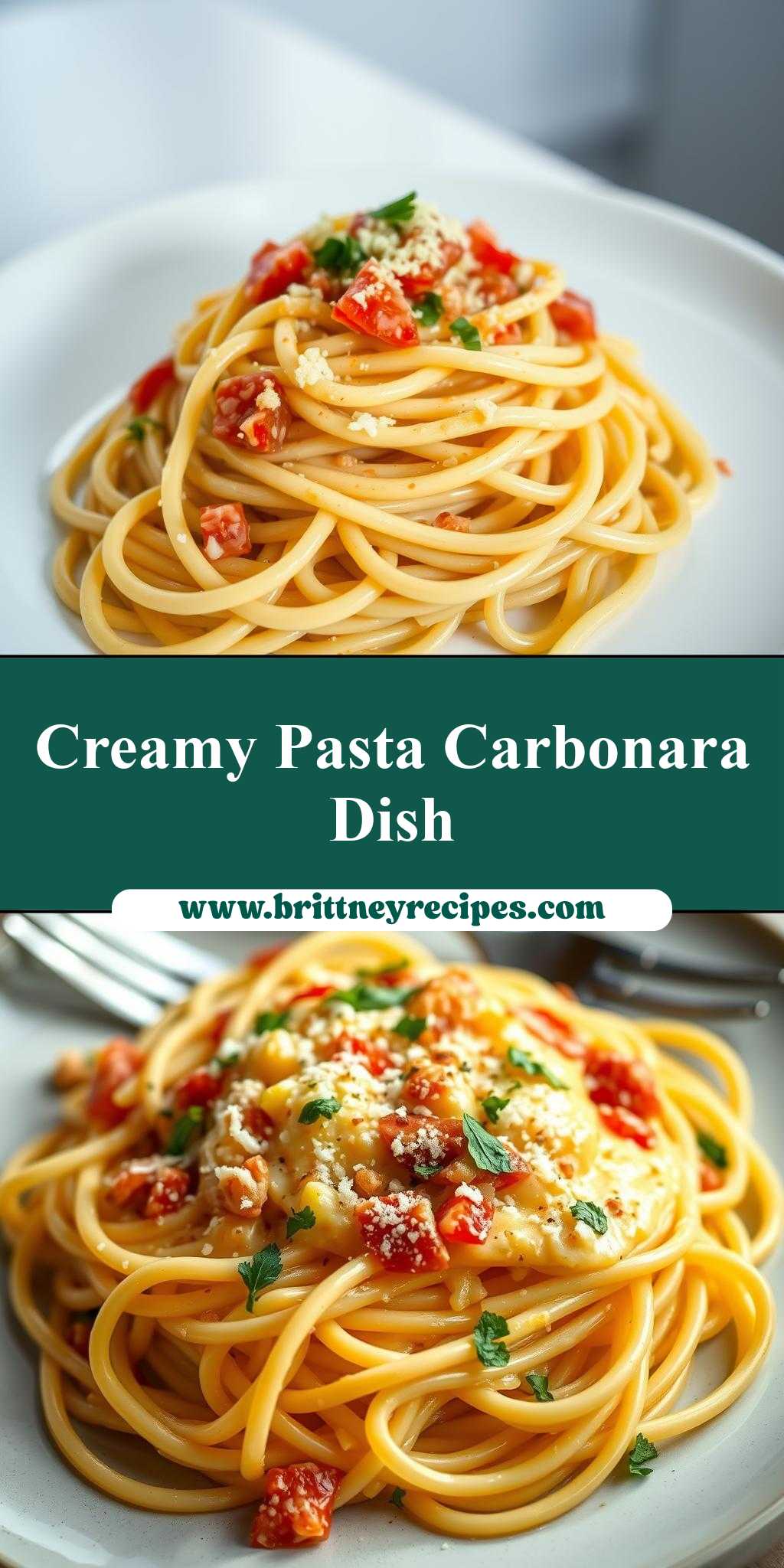What makes the perfect spaghetti carbonara so irresistible? It’s the rich combination of bacon, eggs and parmesan cheese that comes together in a quick and easy homemade dish, perfect for a weeknight dinner. Whip up this family favorite using just a few key ingredients and save this idea for a delicious meal anytime.
Spaghetti Carbonara
Introduction
Spaghetti Carbonara is one of those dishes that embodies the essence of Italian cuisine: simplicity, flavor, and a dash of creativity using everyday ingredients. This beloved pasta dish has become a staple around the world for its rich, creamy sauce, perfectly cooked spaghetti, and the subtle balance of flavors that leave you wanting more. What’s more appealing is that it’s incredibly easy to make and requires minimal ingredients, making it a perfect candidate for a quick dinner or an impressive meal for guests. In this article, we’ll delve into the world of Spaghetti Carbonara, exploring its magic, and providing you with a straightforward recipe to make this Italian delight in the comfort of your own home.
Why This Works
- Flavor balance and ingredient accessibility: The beauty of Carbonara lies in its simplicity. With just a few main ingredients, it’s astonishing how each component complements the others, creating a dish that’s greater than the sum of its parts. The accessibility of these ingredients in most supermarkets around the world adds to its appeal.
- Ease of preparation: Despite its elegant presentation and sophisticated taste, Spaghetti Carbonara is remarkably easy to prepare. The steps are straightforward, and the cooking time is relatively short, making it an ideal choice for both beginners and experienced cooks.
- Impressive results with minimal effort: The end result of this dish is always impressive. The creamy sauce coating the al dente spaghetti, the savory flavor of the bacon or pancetta, and the freshness of the parsley all combine to create a dish that looks and tastes like it was prepared in a professional kitchen, all with minimal effort.
Key Ingredients
The main ingredients in a traditional Spaghetti Carbonara include spaghetti, bacon or pancetta, eggs, parmesan cheese, black pepper, and sometimes parsley for garnish. The quality of these ingredients can significantly impact the final dish. For instance, using guanciale (an Italian cured meat) instead of bacon can add a deeper, more complex flavor. Similarly, fresh eggs and high-quality parmesan cheese are essential for the creamy sauce. For those looking for substitutions, vegetarian options might include replacing bacon with mushrooms or eggplant for a smoky flavor, though it deviates from the traditional recipe.
Instructions
- Step 1: Begin by bringing a large pot of salted water to a boil. Cook the spaghetti according to the package instructions until it’s al dente. Reserve 1 cup of pasta water before draining the spaghetti. This water will be crucial in achieving the right consistency for the sauce.
- Step 2: In a large skillet, cook the diced bacon or pancetta over medium heat until it’s crispy. Remove from heat and let it cool slightly. The rendered fat from the bacon will be used to cook the garlic and eventually mix with the eggs, so don’t discard it.
- Step 3: In a medium bowl, whisk together the eggs, parmesan cheese, and a pinch of salt and pepper. Add the reserved pasta water to the egg mixture in small increments, whisking continuously to prevent the eggs from scrambling when you add the hot pasta later.
- Step 4: Add the cooked spaghetti to the bowl with the egg mixture and toss well to combine, ensuring the spaghetti is well coated with the egg and cheese mixture. Then, add the cooked bacon or pancetta to the spaghetti and toss everything together. The heat from the pasta will cook the eggs slightly, creating a creamy sauce. Season with more black pepper if desired.
Handy Tips
- One of the most common mistakes in making Carbonara is overcooking the spaghetti or scrambling the eggs. To avoid this, make sure to cook the spaghetti al dente and to whisk the egg mixture well before adding the hot pasta. Also, adding the pasta water gradually helps in achieving the perfect sauce consistency.
- For vegetarians looking to replicate the smoky flavor of bacon, using smoked tofu or tempeh can be a good alternative. However, keep in mind that the flavor profile will be different from the traditional recipe.
- Avoid using cream or milk in your Carbonara, as this can make the dish overly rich and heavy. The creaminess should come from the eggs and the pasta water.
Heat Control
Heat control is crucial in making Spaghetti Carbonara. When cooking the bacon or pancetta, medium heat is ideal to prevent burning. When whisking the eggs, it’s essential to add the hot pasta water gradually to prevent the eggs from scrambling. The ideal temperature for the pasta water is a rolling boil, and for the bacon, it’s around medium heat until crispy.
Crunch Factor
The crunch factor in Spaghetti Carbonara comes from the crispy bacon or pancetta. To achieve this, cook the bacon in a skillet over medium heat, stirring occasionally, until it’s golden brown and crispy. This texture contrast between the crunchy bacon, the creamy sauce, and the al dente spaghetti is what makes Carbonara so delightful.
Pro Kitchen Tricks
- Using room temperature eggs helps in whisking them smoother and faster, ensuring a more even sauce.
- Adding a small amount of pasta water to the egg mixture before adding the spaghetti helps in preventing the eggs from scrambling when they meet the hot pasta.
- For an extra creamy sauce, you can add a tablespoon or two of grated parmesan cheese to the egg mixture before tossing it with the spaghetti.
Storage Tips
- Carbonara is best served immediately after preparation. However, if you need to store leftovers, keep them in an airtight container in the refrigerator for up to a day. Reheat gently, adding a bit more pasta water if the sauce has thickened too much.
- Avoid freezing Carbonara as the texture of the eggs and the sauce can become unappealing after thawing and reheating.
- For the best results, use glass or ceramic containers for storing leftovers. Metal can react with the acidity in the tomatoes (if used) or the eggs, affecting the flavor.
Gift Packaging Ideas
While Spaghetti Carbonara is typically not considered a gift food due to its perishable nature, components of it can be beautifully packaged. For instance, a gift basket filled with high-quality spaghetti, parmesan cheese, and a packet of Italian seasonings, along with a recipe card for Carbonara, can be a thoughtful gift for any pasta lover. Wrap each item individually in decorative paper or place them in a nicely arranged basket, finished with a ribbon.
Flavor Variations
- Different spices: Adding a pinch of nutmeg or red pepper flakes can give your Carbonara a unique twist. Nutmeg adds a warm, slightly sweet flavor, while red pepper flakes introduce a spicy kick.
- Creative toppings: While traditional Carbonara is quite minimalist, you can experiment with toppings like cherry tomatoes halved and tossed in olive oil, garlic, and basil, or sautéed mushrooms for added flavor and texture.
- Ingredient swaps: For a seafood version, you could use smoked salmon instead of bacon, combining it with dill and lemon zest for a refreshing twist.
Troubleshooting
- Texture problems: If your sauce turns out too thick, add a bit more pasta water. If it’s too thin, add more parmesan cheese or a bit of the reserved pasta water and whisk vigorously.
- Ingredient replacements: If you can’t find guanciale or pancetta, bacon is a good substitute. For vegetarians, mushrooms or eggplant can provide a meaty texture and smoky flavor when properly seasoned.
- Over/undercooking signs: Overcooked spaghetti will be mushy and unappetizing. Undercooked spaghetti will be too hard. The perfect al dente texture is slightly firm in the center but yielding to the bite.
FAQs
- Can I freeze it? It’s not recommended to freeze Spaghetti Carbonara due to the potential change in texture of the eggs and sauce upon reheating.
- Is it gluten-free? Traditional spaghetti contains gluten, but you can make a gluten-free version by using gluten-free spaghetti.
- Can I double the recipe? Yes, you can easily double or triple the recipe for a larger crowd. Just ensure you have enough pots and pans to cook everything efficiently.
Conclusion
Spaghetti Carbonara is a dish that never fails to impress, with its simplicity, rich flavors, and the satisfaction of creating something truly Italian in your own kitchen. Whether you’re a seasoned chef or a beginner in the culinary world, this recipe is sure to become a staple. Feel free to experiment with different ingredients and variations to make it your own, and don’t hesitate to share your creations with friends and family. The joy of cooking lies not just in the eating, but in the sharing and the love that goes into every dish. Buon appetito!

